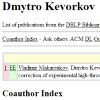| |
|
| |
|
| |
  
Hans-Jürgen Bandelt,
Vincent Macaulay and
Martin Richards. Median networks: speedy construction and greedy reduction, one simulation, and two case studies from human mtDNA. In MPE, Vol. 16:8-28, 2000.
Keywords: from sequences, from splits, median network, phylogenetic network, phylogeny, reconstruction.
Note: http://www.stats.gla.ac.uk/~vincent/papers/speedy.pdf.
Toggle abstract
"Molecular data sets characterized by few phylogenetically informative characters with a broad spectrum of mutation rates, such as intraspecific control-region sequence variation of human mitochondrial DNA (mtDNA), can be usefully visualized in the form of median networks. Here we provide a step-by-step guide to the construction of such networks by hand. We improve upon a previously implemented algorithm by outlining an efficient parametrized strategy amenable to large data sets, greedy reduction, which makes it possible to reconstruct some of the confounding recurrent mutations. This entails some postprocessing as well, which assists in capturing more parsimonious solutions. To simplify the creation of the resulting network by hand, we describe a speedy approach to network construction, based on a careful planning of the processing order. A coalescent simulation tailored to human mtDNA variation in Eurasia testifies to the usefulness of reduced median networks, while highlighting notorious problems faced by all phylogenetic methods in this context. Finally, we discuss two case studies involving the comparison of characters in the two hypervariable segments of the human mtDNA control region in the light of the worldwide control-region sequence database, as well as additional restriction fragment length polymorphism information. We conclude that only a minority of the mutations that hit the second segment occur at sites that would have a mutation rate comparable to those at most sites in the first segment. Discarding the known 'noisy' sites of the second segment enhances the analysis. (C) 2000 Academic Press."
|
|
| |
    
Katharina Huber,
Michael Langton,
David Penny,
Vincent Moulton and
Mike Hendy. Spectronet: A package for computing spectra and median networks. In ABIO, Vol. 1(3):159-161, 2004.
Keywords: from splits, median network, phylogenetic network, phylogeny, Program Spectronet, software, split, visualization.
Note: http://citeseer.ist.psu.edu/631776.html.
Toggle abstract
Spectronet is a package that uses various methods for exploring and visualising complex evolutionary signals. Given an alignment in NEXUS format, the package works by computing a collection of weighted splits or bipartitions of the taxa and then allows the user to interactively analyse the resulting collection using tools such as Lento-plots and median networks. The package is highly interactive and available for PCs.
|
|
| |
   
Katharina Huber,
Vincent Moulton,
Peter J. Lockhart and
Andreas W. M. Dress. Pruned Median Networks: A Technique for Reducing the Complexity of Median Networks. In MPE, Vol. 19(2):302-310, 2001.
Keywords: abstract network, median network, phylogenetic network, phylogeny, split.
Note: http://dx.doi.org/10.1006/mpev.2001.0935.
Toggle abstract
"Observations from molecular marker studies on recently diverged species indicate that substitution patterns in DNA sequences can often be complex and poorly described by tree-like bifurcating evolutionary models. These observations might result from processes of species diversification and/or processes of sequence evolution that are not tree-like. In these cases, bifurcating tree representations provide poor visualization of phylogenetic signals in sequence data. In this paper, we use median networks to study DNA sequence substitution patterns in plant nuclear and chloroplast markers. We describe how to prune median networks to obtain so called pruned median networks. These simpler networks may help to provide a useful framework for investigating the phylogenetic complexity of recently diverged taxa with hybrid origins. © 2001 Academic Press."
|
|
| |

David A. Morrison. Networks in phylogenetic analysis: new tools for population biology. In IJP, Vol. 35:567-582, 2005.
Keywords: median network, NeighborNet, phylogenetic network, phylogeny, population genetics, Program Network, Program Spectronet, Program SplitsTree, Program T REX, Program TCS, reconstruction, reticulogram, split decomposition, survey.
Note: http://hem.fyristorg.com/acacia/papers/networks.pdf.
|
|
| |
 
David Posada and
Keith A. Crandall. Intraspecific gene genealogies: trees grafting into networks. In TEE, Vol. 16(1):37-45, 2001.
Keywords: likelihood, median network, netting, parsimony, phylogenetic network, phylogeny, Program Arlequin, Program SplitsTree, Program T REX, Program TCS, pyramid, reticulogram, split decomposition, statistical parsimony, survey.
Note: http://darwin.uvigo.es/download/papers/09.networks01.pdf.
|
|
| |
|
| |
 
Katharina Huber,
Elizabeth E. Watson and
Mike Hendy. An Algorithm for Constructing Local Regions in a Phylogenetic Network. In MPE, Vol. 19(1):1-8, 2000.
Keywords: abstract network, median network, phylogenetic network, phylogeny, reconstruction, split.
Note: http://dx.doi.org/10.1006/mpev.2000.0891.
Toggle abstract
"The groupings of taxa in a phylogenetic tree cannot represent all the conflicting signals that usually occur among site patterns in aligned homologous genetic sequences. Hence a tree-building program must compromise by reporting a subset of the patterns, using some discriminatory criterion. Thus, in the worst case, out of possibly a large number of equally good trees, only an arbitrarily chosen tree might be reported by the tree-building program as" The Tree." This tree might then be used as a basis for phylogenetic conclusions. One strategy to represent conflicting patterns in the data is to construct a network. The Buneman graph is a theoretically very attractive example of such a network. In particular, a characterization for when this network will be a tree is known. Also the Buneman graph contains each of the most parsimonious trees indicated by the data. In this paper we describe a new method for constructing the Buneman graph that can be used for a generalization of Hadamard conjugation to networks. This new method differs from previous methods by allowing us to focus on local regions of the graph without having to first construct the full graph. The construction is illustrated by an example. © 2001 Academic Press."
|
|
| |
|
| |
  
Steven M. Woolley,
David Posada and
Keith A. Crandall. A Comparison of Phylogenetic Network Methods Using Computer Simulation. In PLoS ONE, Vol. 3(4):e1913, 2008.
Keywords: abstract network, distance between networks, evaluation, median network, MedianJoining, minimum spanning network, NeighborNet, parsimony, phylogenetic network, phylogeny, Program Arlequin, Program CombineTrees, Program Network, Program SHRUB, Program SplitsTree, Program TCS, split decomposition.
Note: http://dx.doi.org/10.1371/journal.pone.0001913.
Toggle abstract
"Background: We present a series of simulation studies that explore the relative performance of several phylogenetic network approaches (statistical parsimony, split decomposition, union of maximum parsimony trees, neighbor-net, simulated history recombination upper bound, median-joining, reduced median joining and minimum spanning network) compared to standard tree approaches (neighbor-joining and maximum parsimony) in the presence and absence of recombination. Principal Findings: In the absence of recombination, all methods recovered the correct topology and branch lengths nearly all of the time when the subtitution rate was low, except for minimum spanning networks, which did considerably worse. At a higher substitution rate, maximum parsimony and union of maximum parsimony trees were the most accurate. With recombination, the ability to infer the correct topology was halved for all methods and no method could accurately estimate branch lengths. Conclusions: Our results highlight the need for more accurate phylogenetic network methods and the importance of detecting and accounting for recombination in phylogenetic studies. Furthermore, we provide useful information for choosing a network algorithm and a framework in which to evaluate improvements to existing methods and novel algorithms developed in the future. © 2008 Woolley et al."
|
|
| |
 
Sarah C. Ayling and
Terence A. Brown. Novel methodology for construction and pruning of quasi-median networks. In BMCB, Vol. 9:115, 2009.
Keywords: abstract network, from sequences, median network, phylogenetic network, phylogeny, quasi-median network, reconstruction.
Note: http://dx.doi.org/10.1186/1471-2105-9-115.
Toggle abstract
"BACKGROUND: Visualising the evolutionary history of a set of sequences is a challenge for molecular phylogenetics. One approach is to use undirected graphs, such as median networks, to visualise phylogenies where reticulate relationships such as recombination or homoplasy are displayed as cycles. Median networks contain binary representations of sequences as nodes, with edges connecting those sequences differing at one character; hypothetical ancestral nodes are invoked to generate a connected network which contains all most parsimonious trees. Quasi-median networks are a generalisation of median networks which are not restricted to binary data, although phylogenetic information contained within the multistate positions can be lost during the preprocessing of data. Where the history of a set of samples contain frequent homoplasies or recombination events quasi-median networks will have a complex topology. Graph reduction or pruning methods have been used to reduce network complexity but some of these methods are inapplicable to datasets in which recombination has occurred and others are procedurally complex and/or result in disconnected networks. RESULTS: We address the problems inherent in construction and reduction of quasi-median networks. We describe a novel method of generating quasi-median networks that uses all characters, both binary and multistate, without imposing an arbitrary ordering of the multistate partitions. We also describe a pruning mechanism which maintains at least one shortest path between observed sequences, displaying the underlying relations between all pairs of sequences while maintaining a connected graph. CONCLUSION: Application of this approach to 5S rDNA sequence data from sea beet produced a pruned network within which genetic isolation between populations by distance was evident, demonstrating the value of this approach for exploration of evolutionary relationships."
|
|
| |

Alain Guénoche. Graphical Representation of a Boolean Array. In Computers and the Humanities, Vol. 20(4):277-281, 1986.
Keywords: from splits, median network, reconstruction.
Note: http://dx.doi.org/10.1007/BF02400118.
Toggle abstract
"In this paper, we represent a boolean array of data with a median connected graph. Vertices are the different lines of the array plus virtual monomials, and an edge links two vertices that are different for only one variable. We describe an algorithm to compute this graph, that is an exact representation of the symmetrical difference distance between lines, and we show an application to Bronze age pins. © 1986 Paradigm Press, Inc."
|
|
|
|
 - forked on GitHub.
- forked on GitHub.
























